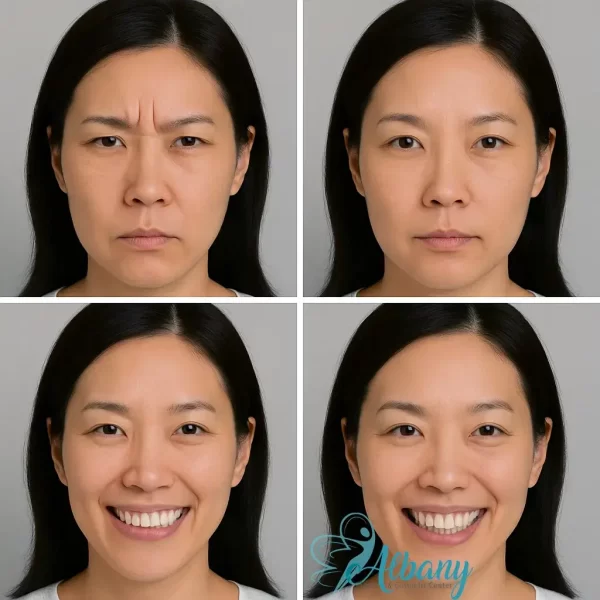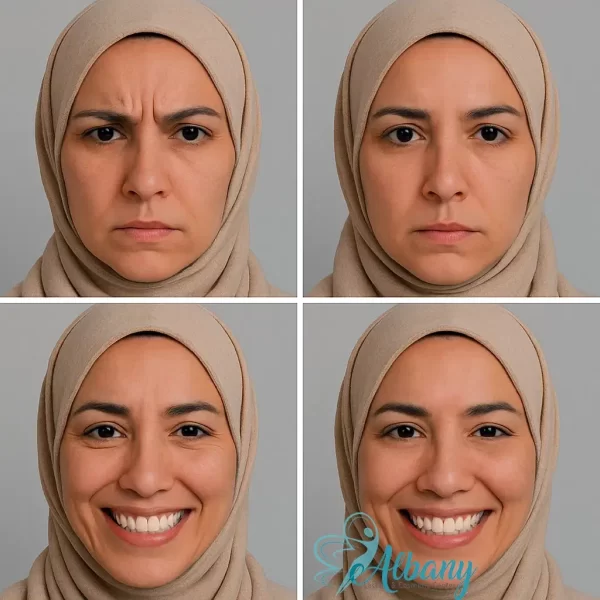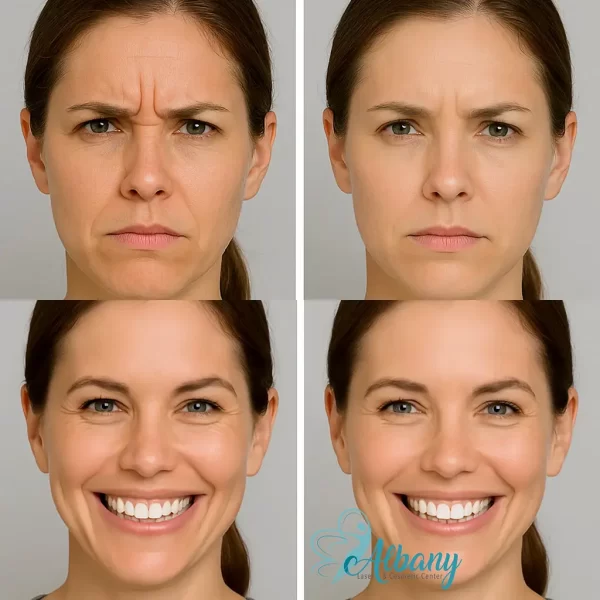Crow’s Feet in Edmonton: Causes, Botox Treatment, Aftercare and More
Crow’s feet are the delicate, fan‑shaped lines that extend from the outer corners of your eyes. They’re often the first dynamic wrinkles to appear because the skin around the eyes is thin and highly expressive. Smiling, laughing and squinting repeatedly crease this area, and as collagen and elastin decline with age, the lines can become etched even when your face is at rest. If these fine lines make you look more tired than you feel, carefully administered Botox can help smooth them. This page explains what causes crow’s feet, how Botox works to relax the muscles responsible and what to expect from treatment at Albany Cosmetic & Laser Centre.
Who Is a Good Candidate for Crow’s‑Feet Botox?



This treatment is best suited for adults who:
- Have dynamic wrinkles around the eyes that appear with smiling, laughing or squinting.
- Are in good overall health without neuromuscular disorders.
- Are not pregnant or breastfeeding.
- Have realistic expectations and understand that results are temporary.
- Do not have an active infection, rash or severe skin irritation around the eye area.
Individuals with deep, static wrinkles or significant skin laxity may require alternative treatments such as dermal fillers, laser resurfacing or surgical procedures. Our providers will advise you during your consultation.
Combining Crow’s‑Feet Botox with Other Procedures
For comprehensive facial rejuvenation, crow’s‑feet treatment can be paired with other services:
- Forehead and frown‑line injections: Smooth the horizontal lines on your forehead and the vertical “11s” between your brows to refresh your entire upper face.
- Dermal fillers: Address static wrinkles, hollows or volume loss in the cheeks, tear troughs or temples to complement the smoothing effect of Botox.
- Skin resurfacing: Chemical peels, microneedling or laser treatments improve skin texture and support collagen production, enhancing overall results.
- Lash and brow enhancements: Combine Botox with lash lifts or brow shaping to open the eyes and complete your aesthetic transformation.
We’ll help you design a personalised treatment plan that meets your aesthetic goals and fits your lifestyle.
Crow’s‑Feet Treatment Summary
Cost & Pricing
What To Expect
Mechanism of Action
Benefits & Results
Post-Treatment Care
Side Effects & Downtime
What Are Crow’s Feet?
Crow’s feet—also known as laughter lines or smile lines—are fine wrinkles that radiate outward from the outer corners of the eyes. They are considered dynamic wrinkles because they form when the orbicularis oculi muscle contracts as you smile, squint or laugh. When you’re young, the skin’s elasticity allows these creases to disappear once the muscle relaxes. Over time, repeated movements combined with a natural decline in collagen and elastin cause the lines to remain visible even at rest.
Why Do Crow’s Feet Appear?
Several factors contribute to the formation of crow’s feet:
- Repetitive facial expressions: Smiling, laughing and squinting contract the orbicularis oculi muscle, creating creases that gradually imprint on the skin.
- Loss of collagen and elastin: With age, your body produces less collagen and elastin, reducing skin elasticity and making wrinkles more apparent.
- Sun exposure: Ultraviolet radiation breaks down collagen and accelerates skin ageing, deepening eye wrinkles.
- Smoking and alcohol: Smoking slows blood flow and damages collagen fibres, while excessive alcohol dehydrates the skin, both of which can make lines more visible.
- Genetics and lifestyle: Your skin type, facial structure and habits like frequent squinting (e.g., due to bright sunlight) also influence how early and deeply crow’s feet form.
How Botox Works for Crow’s Feet
Botox is a purified form of botulinum toxin type A. When injected into the orbicularis oculi muscle, it temporarily blocks the nerve impulses that cause muscle contractions. This relaxation softens the appearance of crow’s feet and prevents new creases from forming during facial expressions. Because the dosage is tailored and injection points are precise, you’ll still be able to smile and squint naturally without developing excessive lines.
Benefits of Treating Crow’s Feet with Botox
-
Smooths Fine Lines and Prevents Deeper Wrinkles
Relaxing the muscles that cause crow’s feet softens existing lines and reduces the formation of new creases, helping you look rested and refreshed.
Fast, Non‑Surgical Procedure
Botox injections for crow’s feet are quick and require no incisions or recovery time, making them easy to fit into a busy schedule.
Natural‑Looking Results
An experienced injector will deliver just enough product to relax the targeted muscles while preserving your ability to smile, laugh and express emotions naturally.
Long‑Lasting and Preventive
Results last for several months, and regular treatments can prevent lines from deepening over time. Many people find that with consistent use, they need fewer units to achieve the same effect.
Why Choose Albany Cosmetic & Laser Centre for Crow’s‑Feet Botox?
- At Albany Cosmetic & Laser Centre, we combine medical precision with artistic sensibility to ensure your crow’s‑feet treatment looks seamless and natural. Here’s what sets us apart:
- Expert injectors: Our physicians and nurses have extensive training in facial anatomy and years of experience administering neuromodulators.
- Personalised care: We assess your muscle strength, skin quality and desired outcome to determine the exact number of units and injection points.
- Comprehensive services: We can treat multiple areas in a single appointment and offer packages that include fillers, peels or laser treatments for overall rejuvenation.
- Safety and satisfaction: We adhere to strict medical standards, use only genuine products and provide thorough aftercare instructions to ensure optimal results.
Transparent Pricing
We believe in clear, upfront pricing. During your consultation, we’ll estimate how many units you need—typically 10–12 per side—and discuss the cost per unit (between $10 and $15). If you’re treating several areas at once, we’ll design a package or membership plan to make your treatment more cost‑effective.
Frequently Asked Questions
- What exactly are crow’s feet?
- Crow’s feet are small, radiating wrinkles that appear at the outer corners of the eyes. They are caused by repeated contraction of the orbicularis oculi muscle during expressions like smiling, laughing and squinting.
- How many units of Botox do I need?
- Most people require 10–12 units per eye, though the exact number depends on the strength of your eye muscles, the depth of your lines and your desired outcome. Men or those with stronger muscles may need slightly more.
- How much does crow’s‑feet treatment cost?
- At Albany Cosmetic & Laser Centre, unit pricing ranges from $10 to $15. Since crow’s feet typically require 20–24 units in total, you can expect to pay between $200 and $360. Package pricing may lower the per‑unit cost if you treat multiple areas at once.
- When will I see results and how long do they last?
- Initial improvements are usually noticeable within three to five days. Full results appear by one to two weeks. The smoothing effect lasts about three to four months, after which muscle activity gradually returns.
- Does the procedure hurt?
- Discomfort is minimal. Most patients describe the injections as quick pinches. A topical anaesthetic or ice pack can be used to numb the area if you’re concerned about sensitivity.
- What are the side effects?
- Mild redness, swelling, bruising or tenderness around the eyes is normal and subsides within a few days. Temporary dry eyes, tearing or a mild headache may occur. Rarely, drooping eyelids or uneven results can happen if the injection is not placed correctly. Choosing an experienced provider reduces this risk.
- What should I avoid after treatment?
- For the first 24 hours, avoid lying down, rubbing your eyes or applying makeup or skincare to the treated area. Skip strenuous exercise, hot baths, saunas and alcohol. Keep your head elevated when sleeping and avoid wearing tight headbands or hats that press on your forehead.
- How often should I repeat crow’s‑feet Botox?
- Maintenance treatments every three to four months keep the muscle relaxed and prevent lines from returning. Over time, some patients find they need fewer units to achieve the same effect.
- Can I treat crow’s feet and other areas at the same time?
- Yes. It’s common to combine crow’s‑feet injections with treatments for forehead lines, frown lines, bunny lines or lip flips. This ensures balanced results and may offer package savings.
- Is crow’s‑feet Botox suitable for men?
- Absolutely. Men develop crow’s feet just like women and can benefit from Botox. Because men often have stronger facial muscles, they may require a slightly higher dose for optimal results.
- Will I still be able to smile naturally?
- Yes. When injected skillfully, Botox relaxes only the targeted portion of the muscle, preserving your ability to smile, laugh and express emotions without looking frozen.
- Are there alternatives to Botox?
- For deep, static wrinkles or skin laxity, dermal fillers, laser resurfacing, chemical peels or microneedling may be more appropriate. We will recommend the best option during your consultation.
- When should I contact a doctor?
- If you experience severe pain, difficulty breathing, swallowing or speaking, vision changes, signs of infection (fever, pus) or extensive drooping, seek immediate medical attention. These complications are rare but require prompt evaluation.
Preparation and Aftercare Timeline
Preparing for Your Appointment
Proper preparation minimises bruising and helps you achieve the best results:
- Discontinue blood‑thinning medications (aspirin, ibuprofen, fish oil) and herbal supplements a day or two beforehand, if approved by your doctor.
- Avoid alcohol and smoking for 24 hours before treatment to reduce swelling and bruising.
- Arrive with a clean face free of makeup, moisturisers or sunscreen around the eye area.
- Inform us of any medical conditions, neuromuscular disorders or past adverse reactions to injections.
- Consider wearing sunglasses if you’ll be sensitive to light after the procedure.
What to Expect During the Procedure
Your appointment begins with a consultation to assess your crow’s feet. Once we agree on the dosage, we’ll cleanse the area and may apply a cold pack or numbing cream for comfort. Using a tiny needle, we’ll administer several small injections along the outer corners of each eye. The process takes only a few minutes and is generally well‑tolerated. You can head back to work or daily activities right after your visit.
Aftercare and Recovery
Following these guidelines helps your Botox settle correctly and minimises side effects:
- Stay upright: Avoid lying down or bending over for at least four hours after treatment to prevent product migration.
- Hands off: Do not rub, press or massage the injection sites for 24 hours. Refrain from pulling at the skin around your eyes or applying heavy skincare products.
- Skip strenuous activity: Wait 24 hours before high‑intensity exercise, hot yoga, saunas or steam rooms. Increased blood flow can diffuse the Botox and worsen swelling.
- Avoid alcohol and smoking: Both can exacerbate bruising and delay healing. Hold off for at least a day after your injections.
- No makeup around the eyes: Avoid eye makeup, creams and serums for 24 hours to prevent unintentional rubbing.
- Sun protection: Wear sunglasses and broad‑spectrum sunscreen to protect the delicate skin around your eyes from UV damage.
- Cold compress: If swelling or bruising occurs, apply a cold pack wrapped in cloth for 10‑minute intervals to reduce discomfort.
- Patience: Don’t judge your results immediately. Full effects are visible within two weeks.
- Monitor your symptoms: Contact us if you experience unusual symptoms such as vision changes, droopy eyelids or signs of infection.
Read our privacy policy here